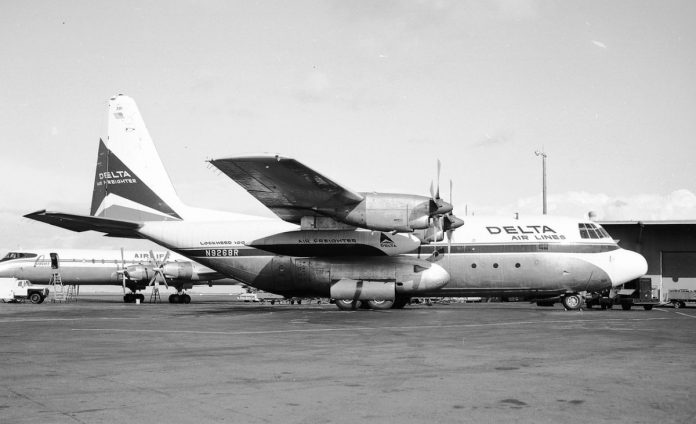Nearly five decades ago, Delta Air Lines retired its Lockheed L-100 aircraft. The Atlanta-based carrier was proud to hold this cargo-only type between the middle of the 1960s and 1970s. Here is a look at the airline’s relationship with the plane.

Built for challenging operations
The Delta flight museum highlights that the L-100 was a commercial version of the military Lockheed C-130 Hercules. The aircraft could land on unimproved short strips. However, it could still carry heavy vehicles and goods.
The commercial edition was built by Lockheed in Marietta, Georgia, not so far away from Delta’s home of Atlanta. The carrier took on the plane to help with its short-haul, small shipment cargo network at the time.
The company was interested in the model as it had greater payload and speed than the Curtiss C-46, which it flew with from 1957. The first L-100 unit arrived on August 18th, 1966, and the type entered service on September 15th, 1966.
Subsequently, Delta performed the world’s ever first commercial L-100 service. Additionally, the plane helped the airline provide the first single-carrier cargo operation between California and the Southeast. This move bridged a gap between the aviation markets in the two areas.
The plane was powered by four Allison 501-D22 turboprops, helping it to reach speeds of up to 361 mph. It also had a range of 1,800 miles. However, one of the most noticeable aspects of the L-100 was its size. It had a length of 112 feet, a wingspan of 132 feet, and a height of 38 feet.

High expectations
A brochure of Delta’s L-100 shared by the Delta Flight Museum shows that Delta was delighted to have such a plane in its fleet. It was notably excited about the size of the aircraft.
“Truly, this is a giant of an airplane—over 97 feet long and 38 feet high—with all the rugged can-do of a massive trailer truck. In fact, it’s the one aircraft that combines the best features of a plane and a truck, built specifically to carry cargo. It’s big and brawny and built to take more rough treatment than it will ever know in Delta service. (The Air Force uses it for assault landings on rough cleared strips as a matter of routine!)” Delta said in its brochure.
“Brawn isn’t the whole story. There’s speed! The Hercules can be loaded in 20 to 30 minutes, gets off the ground in short order, reaches cruising altitude quickly. It cruises at an easy 350 mph with the smooth power of four 4,050 equivalent shaft hp Allison turboprop engines. At that speed—with a 45,000-pound payload and 1,900-mile range—the Hercules gets tons of goods to destinations many hundreds of miles away in a few quick hours…from Chicago to Atlanta, for example, in [2.25 hours], or from Dallas to Los Angeles in [4.5 hours].”

A trusted addition
Delta was proud of the cargo abilities of the Lockheed Hercules. It felt that the aircraft was highly dependable when it came to carrying heavy loads thanks to its deployment across the globe. For instance, In a period of ten consecutive days in Vietnam, a C-130 military version of the Hercules flew 100 sorties, delivering 500 tons of materials with the operation. Thanks to the plane’s low maintenance, there was also no time lost due to mechanical difficulties that aircraft would often face on these journeys.
After two years of operating the plane, Delta began returning L-100-10s to Lockheed for a fuselage stretch of 8.3 feet. These planes were re-designated as model L-100-20. Subsequently, Delta was the first carrier to deploy the stretched L-100-20. During this modification period, the airline leased several L-100s from the manufacturer to keep services going.
Nonetheless, despite being giant for its time, the plane could operate in and out of most city hubs. It could depart and land on runways that hand lengths of a little more than 5,000 feet. So, Delta could cater to market segments that were not previously open to such high freight capacity.

A changing market
The L-100 didn’t have such a long lifespan in Delta’s fleet. The carrier only operated it for less than a decade. Widebody passenger jets were all the rage by the early 1970s, and the airline was hitting the skies with its Boeing 747 and Douglas DC-10 aircraft. It would also take on a series of other jets in the decades that followed.
These jets had great speed and also held large underfloor capacity in their bellies. Now, Delta could efficiently mix cargo and passenger operations on the same aircraft. So, it didn’t need cargo-only units anymore. Therefore, on September 1st, 1973, the L-100 performed its last operation with the firm. After that, the airline officially retired the plane on March 30th, 1974.

Altogether, Delta owned three of these L-100 aircraft. It also held five more units on short-term leases. Airlines rarely have cargo-only models within their fleets these days as they can effectively convert passenger units or mix services. However, before widebody jets took the aviation industry by storm, planes such as the L-100 were helpful additions for carriers to meet demand.
What are your thoughts about Delta Air Lines’ operations with the Lockheed L-100? Did you ever spot this aircraft in the skies over the years? Let us know what you think of the plane in the comment section.
[ad_2]
Source link

